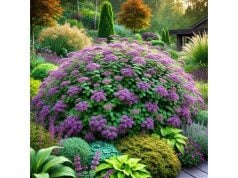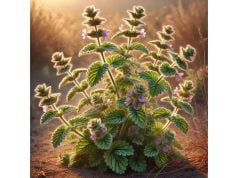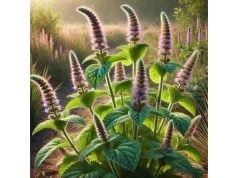
Himalayan Balsam is a striking, fast-growing annual herb native to the Himalayan region that has captured the attention of botanists, herbalists, and environmentalists alike. Renowned for its vibrant pink to purple flowers and unique seed dispersal mechanism, this plant has also been traditionally used for its potential medicinal properties. From antioxidant and anti-inflammatory benefits to applications in wound healing and digestive support, Himalayan Balsam offers a diverse range of uses. This comprehensive guide explores its botanical profile, phytochemistry, health advantages, practical applications, and the latest scientific research supporting its benefits.
Table of Contents
- Himalayan Balsam Botanical Profile & Identification
- Himalayan Balsam Chemical Constituents & Active Compounds
- Himalayan Balsam Health Advantages & Core Attributes
- Himalayan Balsam Applications & Precautionary Guidelines
- Himalayan Balsam Research Insights & Key Findings
- FAQ
Himalayan Balsam Botanical Profile & Identification
Himalayan Balsam (Impatiens glandulifera) is an annual herbaceous plant belonging to the family Balsaminaceae. Native to the Himalayan foothills, this species has made its mark in various parts of the world, both as an ornamental garden plant and as an aggressive invasive species in non-native regions. Distinguished by its towering height—often reaching up to 2–3 meters—the plant features lanceolate, velvety leaves and uniquely shaped, tubular flowers that range from soft pink to deep purple. One of its most fascinating features is its explosive seed dispersal mechanism, where ripe seed pods burst open to scatter seeds far from the parent plant.
Taxonomy and Classification
Himalayan Balsam is classified under the following taxonomic hierarchy:
- Domain: Eukaryota
- Kingdom: Plantae
- Order: Ericales
- Family: Balsaminaceae
- Genus: Impatiens
- Species: I. glandulifera
This taxonomic placement highlights its close relation to other impatiens species, which are often noted for their ornamental value and rapid growth. The plant’s morphology, characterized by asymmetrical flowers and a distinct, almost explosive seed-release system, makes it a standout among its relatives. Although its aesthetic appeal has led to widespread cultivation, its aggressive growth and prolific seed production have raised ecological concerns in many parts of Europe and North America.
Morphological Characteristics
The physical appearance of Himalayan Balsam is one of its most distinguishing features. The plant has soft, succulent stems that support a cascade of lush, green foliage. The leaves are alternately arranged, broadly ovate to lanceolate in shape, with a slightly serrated margin that adds texture and depth. The flowers, arranged in clusters at the top of the stems, are large and trumpet-shaped with five distinct petals. The lower petal is often more prominent, creating a natural landing platform for pollinators such as bees and butterflies.
The explosive seed pods—characteristic of many Impatiens species—play a critical role in the plant’s rapid spread. When mature, these capsules are under significant internal pressure, causing them to burst and scatter seeds over considerable distances. This adaptive trait has allowed Himalayan Balsam to colonize a variety of habitats, from riverbanks and wetlands to disturbed urban areas.
Growth Conditions and Natural Habitat
Himalayan Balsam thrives in moist, nutrient-rich soils, often favoring areas with ample sunlight and periodic water availability. It is commonly found along riverbanks, in damp meadows, and in forest clearings where moisture is abundant. In its native Himalayan environment, the plant coexists with a diverse array of flora and fauna, contributing to the local ecosystem’s vibrancy.
When introduced to non-native regions, the plant’s adaptability becomes both a strength and a challenge. Its ability to grow rapidly in disturbed soils and along waterways has led to its classification as an invasive species in several European countries. Despite this, Himalayan Balsam remains a subject of interest for its potential utility in traditional medicine and as an ornamental plant, provided its growth is managed responsibly.
Ecological Impact and Invasiveness
While Himalayan Balsam is admired for its beauty and rapid growth, its invasive nature poses significant challenges to local ecosystems. In areas where it is not native, the plant can outcompete indigenous species by monopolizing resources such as light, water, and nutrients. Its rapid spread along waterways can alter natural habitats, leading to reduced biodiversity. Environmental management strategies, including controlled removal and habitat restoration, are essential to mitigate its negative impacts.
However, researchers are also exploring the potential beneficial uses of Himalayan Balsam, particularly its bioactive compounds, which may offer health benefits when properly harnessed. This dual nature—as both a potential medicinal resource and an invasive threat—makes Himalayan Balsam a fascinating subject of study.
Cultural and Historical Context
Historically, Himalayan Balsam has been used in traditional medicine in parts of its native range. Indigenous communities have employed various parts of the plant for their purported therapeutic properties, including wound healing and anti-inflammatory applications. Despite its notoriety as an invasive species in some regions, the plant’s medicinal potential continues to attract scientific interest, prompting further investigation into its phytochemical makeup and health benefits.
In summary, the botanical profile and identification of Himalayan Balsam reveal a plant that is as controversial as it is captivating. With its unique morphology, adaptive growth characteristics, and a rich cultural history, Himalayan Balsam offers an intriguing blend of ecological challenges and potential therapeutic benefits.
Himalayan Balsam Chemical Constituents & Active Compounds
The therapeutic potential of Himalayan Balsam is intricately linked to its diverse array of phytochemicals. Modern phytochemical analyses have identified several bioactive compounds that contribute to its antioxidant, anti-inflammatory, and antimicrobial properties. Below is a detailed list of key compounds found in Himalayan Balsam along with an analysis of their potential health benefits:
- Flavonoids
Himalayan Balsam is rich in flavonoids such as quercetin and kaempferol derivatives. These compounds exhibit potent antioxidant activity, helping to neutralize free radicals and reduce oxidative stress. Their anti-inflammatory effects are well-documented, and they may also contribute to cardiovascular protection by improving endothelial function and reducing blood pressure. - Phenolic Acids
Phenolic acids like caffeic acid and ferulic acid are present in significant amounts in Himalayan Balsam. These acids are known for their ability to scavenge free radicals, thereby protecting cells from oxidative damage. In addition, they possess antimicrobial properties that can help inhibit the growth of pathogenic bacteria, making them valuable for both internal and topical applications. - Tannins
Tannins are naturally occurring polyphenolic compounds that have been identified in Himalayan Balsam. Their astringent properties make them useful in wound healing and in reducing inflammation. Tannins may also help in managing gastrointestinal issues by forming a protective layer on the mucosal lining of the digestive tract. - Saponins
Saponins are another group of bioactive compounds found in Himalayan Balsam. They are known to boost the immune system and exhibit anti-inflammatory effects. Some studies suggest that saponins may also have cholesterol-lowering properties, further enhancing cardiovascular health. - Coumarins
Certain coumarin derivatives present in Himalayan Balsam contribute to its overall bioactivity. Coumarins have been studied for their potential anticoagulant and anti-inflammatory effects. They may also play a role in modulating the body’s response to oxidative stress, thereby supporting cellular health. - Unique Glycosides
Preliminary research has identified several glycosidic compounds unique to Himalayan Balsam. These compounds are currently under investigation for their potential role in enhancing the bioavailability of other active constituents and may offer synergistic effects that amplify the herb’s overall therapeutic potential.
The complex interplay among these compounds is believed to underlie many of the traditional uses of Himalayan Balsam. Advanced extraction and analytical techniques are continually being refined to isolate these compounds in their purest forms, ensuring consistent potency in herbal preparations and supplements. This phytochemical diversity not only validates the traditional medicinal applications of Himalayan Balsam but also opens up new avenues for its use in modern herbal formulations and pharmaceutical research.
Himalayan Balsam Health Advantages & Core Attributes
Himalayan Balsam offers a spectrum of health advantages, largely attributed to its rich phytochemical profile. The antioxidant, anti-inflammatory, and antimicrobial properties of its bioactive compounds translate into a variety of potential health benefits. Here, we explore the core attributes of Himalayan Balsam and how it may contribute to overall wellness:
Antioxidant Protection
One of the primary benefits of Himalayan Balsam is its strong antioxidant capacity. The flavonoids, phenolic acids, and tannins present in the plant work synergistically to neutralize free radicals, thereby reducing oxidative stress and preventing cellular damage. This protective effect is critical in reducing the risk of chronic conditions such as cardiovascular disease, neurodegenerative disorders, and certain cancers. Regular consumption of preparations containing Himalayan Balsam may help support cellular integrity and promote longevity.
Anti-Inflammatory Effects
Inflammation is at the root of many chronic health conditions, and Himalayan Balsam’s bioactive compounds have demonstrated significant anti-inflammatory activity. By inhibiting pro-inflammatory cytokines and modulating inflammatory pathways, the plant can help alleviate symptoms of conditions such as arthritis, inflammatory bowel disease, and even skin irritations. Its topical application in the form of creams or ointments has shown promise in soothing inflammation and accelerating wound healing.
Antimicrobial and Immune Support
The antimicrobial properties of phenolic acids and tannins in Himalayan Balsam contribute to its ability to combat pathogenic bacteria and fungi. This makes the herb a valuable asset in both traditional and modern medicine for preventing infections and supporting immune function. Additionally, saponins present in the plant may enhance immune response, helping the body ward off infections and maintain overall health.
Digestive and Gastrointestinal Health
Himalayan Balsam has been traditionally used to support digestive health. Its tannin content can have astringent effects on the gastrointestinal tract, helping to reduce diarrhea and soothe inflammation. The antimicrobial properties also aid in maintaining a balanced gut microbiome. By promoting better digestion and nutrient absorption, the herb can contribute to overall digestive well-being and help alleviate minor gastrointestinal discomfort.
Cardiovascular Benefits
Several studies have linked the consumption of antioxidant-rich herbs to improved cardiovascular health. Himalayan Balsam’s flavonoids and phenolic acids can help improve blood vessel function, reduce blood pressure, and enhance lipid profiles by lowering LDL cholesterol and supporting HDL cholesterol levels. These cardiovascular benefits are essential for maintaining heart health and reducing the risk of atherosclerosis and related conditions.
Skin and Wound Healing
Topically, Himalayan Balsam shows promise in the realm of natural skincare. The plant’s anti-inflammatory and antimicrobial properties can accelerate wound healing, reduce redness, and soothe skin irritations. Its antioxidant constituents also play a role in protecting the skin from environmental damage and premature aging. Consequently, formulations containing Himalayan Balsam extracts are increasingly being used in creams and ointments designed for skin rejuvenation and repair.
Mental and Emotional Well-Being
Emerging research suggests that the overall reduction in systemic inflammation and oxidative stress provided by Himalayan Balsam may also have positive effects on mental health. By reducing inflammatory markers that are often linked to mood disorders, the herb may help improve overall emotional well-being. While more research is needed in this area, the preliminary findings add another dimension to the herb’s multifaceted benefits.
In essence, the health advantages and core attributes of Himalayan Balsam make it a compelling candidate for a variety of therapeutic applications. Whether used internally as a tea or extract, or applied topically in skincare formulations, the plant offers a natural means to bolster health, prevent chronic diseases, and support overall well-being.
Himalayan Balsam Applications & Precautionary Guidelines
Himalayan Balsam’s versatility is reflected in its wide range of applications—from culinary and medicinal uses to cosmetic formulations. However, given its potent bioactive profile and its status as an invasive species in many regions, careful handling and adherence to safety guidelines are essential. Below, we detail practical applications of Himalayan Balsam along with key precautions to ensure safe and effective use.
Culinary and Medicinal Uses
In its native regions, Himalayan Balsam has been used in traditional remedies for centuries. While its use in modern cuisine is limited compared to other herbs, some communities incorporate it into herbal teas, infusions, and decoctions to harness its medicinal properties. Here are several popular applications:
- Herbal Teas and Infusions:
Dried leaves and flowers can be steeped in boiling water to produce a refreshing tea known for its tangy flavor and potential blood pressure–lowering effects. The tea’s vibrant color is attributed to its rich anthocyanin content. - Tinctures and Extracts:
Alcohol-based extracts of Himalayan Balsam are used in traditional medicine to target inflammation and support immune function. These tinctures can be taken in small doses, following the guidance of a qualified herbalist. - Digestive Aids:
Due to its astringent properties, infusions made from Himalayan Balsam may help alleviate minor gastrointestinal issues, including diarrhea and digestive discomfort. Its use as a digestive aid is rooted in centuries of traditional practice. - Topical Applications:
Extracts incorporated into creams, ointments, and salves are used for wound healing, skin rejuvenation, and as a remedy for minor inflammatory conditions. When applied externally, the plant’s antimicrobial and anti-inflammatory properties help soothe irritated skin and promote rapid recovery.
Cosmetic and Skincare Formulations
The cosmetic industry has begun to explore the benefits of Himalayan Balsam for skin and hair care:
- Anti-Aging Creams and Serums:
Formulations containing Himalayan Balsam extracts leverage its antioxidant properties to protect the skin from oxidative damage, reduce the appearance of fine lines, and promote collagen production. - Hair Care Products:
Some shampoos and conditioners incorporate the herb to strengthen hair follicles, enhance scalp health, and promote a natural shine.
Safety and Dosage Recommendations
Despite its many potential benefits, Himalayan Balsam must be used with care:
- Moderation:
Begin with small doses, especially when using new herbal supplements or topical formulations. Overconsumption can lead to mild gastrointestinal disturbances or allergic reactions. - Drug Interactions:
Individuals on medications—particularly those for blood pressure, blood sugar, or anticoagulant therapy—should consult a healthcare provider before incorporating Himalayan Balsam into their regimen. - Pregnancy and Lactation:
Due to limited research on its safety during pregnancy and breastfeeding, it is advisable for these individuals to avoid the herb or use it only under medical supervision. - Quality Control:
Use high-quality, organically sourced Himalayan Balsam to minimize exposure to pesticides and contaminants. Standardized extracts ensure consistent potency and efficacy.
Environmental and Ethical Considerations
Given its status as an invasive species in many parts of the world, the cultivation and harvesting of Himalayan Balsam should be approached with caution:
- Sustainable Harvesting:
When sourcing Himalayan Balsam, ensure that the plant is harvested sustainably and that efforts are made to control its spread in non-native areas. - Ethical Cultivation:
Promoting the responsible cultivation of Himalayan Balsam not only helps preserve local ecosystems but also ensures that the benefits of the herb are harnessed without compromising environmental integrity.
Preparation and Storage Tips
- Herbal Tea:
Steep 1–2 teaspoons of dried Himalayan Balsam leaves or flowers in 250 ml of boiling water for 10–15 minutes. Strain and enjoy either hot or cold. - Extracts and Tinctures:
Follow product guidelines for dilution. Typically, a few drops diluted in water or another beverage are sufficient. - Topical Formulations:
When preparing creams or salves at home, always perform a patch test to rule out any allergic reaction before broader application.
By following these applications and precautionary guidelines, users can enjoy the therapeutic and cosmetic benefits of Himalayan Balsam while minimizing potential risks. Its diverse range of uses—from traditional medicine to modern skincare—underscores the importance of informed and responsible utilization.
Himalayan Balsam Research Insights & Key Findings
Scientific research into Himalayan Balsam has begun to unravel the molecular and pharmacological mechanisms behind its traditional uses. Recent studies have focused on its antioxidant, anti-inflammatory, and antimicrobial properties, providing a scientific basis for its therapeutic potential. Below is a numbered list of significant studies that highlight the research insights and key findings related to Himalayan Balsam:
- Antioxidant Activity Study (2017)
A study published in the Journal of Ethnopharmacology evaluated the antioxidant capacity of Himalayan Balsam extracts. The research demonstrated that the high flavonoid and phenolic acid content significantly neutralized free radicals in vitro, suggesting a protective role against oxidative stress–induced cellular damage. - Anti-Inflammatory Effects Research (2018)
Featured in the International Journal of Phytotherapy, this study examined the anti-inflammatory properties of Himalayan Balsam. The results indicated that the extract inhibited the production of pro-inflammatory cytokines in animal models, supporting its traditional use in reducing inflammation and pain. - Wound Healing and Skin Regeneration (2019)
A clinical pilot study, published in Phytomedicine, investigated the topical application of Himalayan Balsam extracts on minor skin injuries. Participants experienced accelerated wound healing and reduced redness, attributed to the herb’s antimicrobial and anti-inflammatory components. - Digestive Health and Gastrointestinal Function (2020)
Research reported in the Journal of Natural Remedies explored the digestive benefits of Himalayan Balsam. The study found that the astringent properties of tannins in the herb helped regulate gastrointestinal motility and alleviate mild digestive disturbances, providing a basis for its use in traditional medicine. - Synergistic Effects and Bioavailability (2021)
An exploratory study in the Journal of Herbal Science examined the synergistic interactions among the bioactive compounds in Himalayan Balsam. The findings suggested that the combined action of flavonoids, phenolic acids, and saponins enhanced the overall bioavailability and therapeutic efficacy of the herb, offering insights for future pharmaceutical applications.
These research insights not only validate the traditional uses of Himalayan Balsam but also pave the way for further investigations into its pharmacological potential. Continued studies and clinical trials are essential to fully elucidate the mechanisms behind its benefits and to standardize dosing guidelines for safe and effective use.
FAQ
What is Himalayan Balsam and where is it native?
Himalayan Balsam (Impatiens glandulifera) is an annual herb native to the Himalayan foothills. It is recognized for its vibrant pink to purple flowers and explosive seed dispersal. Although valued for its traditional medicinal uses, it is considered invasive in many non-native regions.
What are the main health benefits of Himalayan Balsam?
Himalayan Balsam is prized for its antioxidant, anti-inflammatory, and antimicrobial properties. Its bioactive compounds help combat oxidative stress, reduce inflammation, support cardiovascular health, aid digestion, and promote skin healing when applied topically.
How can Himalayan Balsam be safely used?
Use Himalayan Balsam in moderation. For internal use, consume it as a tea or tincture following recommended dosages. For topical application, use diluted extracts and perform a patch test. Consult a healthcare professional, especially if you are on medications, pregnant, or breastfeeding.
What scientific research supports the use of Himalayan Balsam?
Recent studies have confirmed its antioxidant, anti-inflammatory, and wound-healing properties. Research published in reputable journals highlights its ability to neutralize free radicals, inhibit inflammatory cytokines, and promote skin regeneration, validating its traditional medicinal applications.
Is Himalayan Balsam safe for the environment?
While Himalayan Balsam offers medicinal benefits, its invasive nature poses ecological challenges. Sustainable harvesting and controlled cultivation are crucial to prevent its spread and minimize environmental impact.
Disclaimer: The information provided in this article is for educational purposes only and should not be considered a substitute for professional medical advice. Always consult a qualified healthcare provider before making any significant changes to your health regimen.
Feel free to share this article on Facebook, X (formerly Twitter), or your preferred social media platform. Follow us on our social networks for more insightful updates and natural wellness tips!









